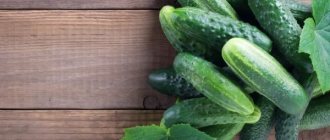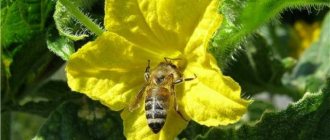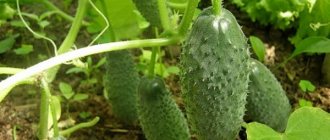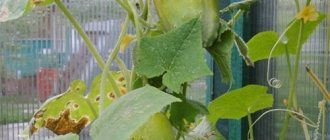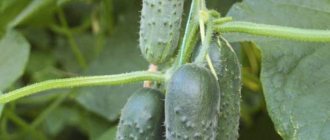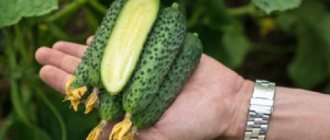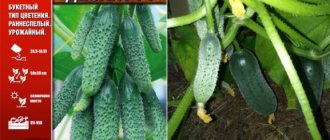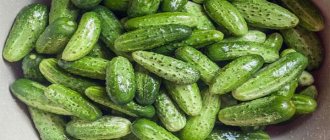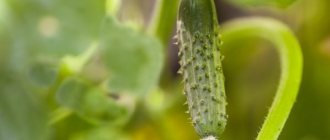The relatively young hybrid Lastochka F1 is superior in productivity to such varieties as Nezhensky and Konkurent. It is characterized by easy care, excellent adaptation abilities, and high knotting ability. This cucumber is cultivated in open and covered beds.
| Landing location | Ripening time | Mode of application | Fruit length | Group | Fruit smoothness | Pollination method |
| Universal | Early ripening (35-45 days) | Universal | Medium - from 10 to 15 cm | Hybrid | Highly lumpy | Bee pollinated |
Type of fruit
Swallow is grown in Ukraine, Moldova, and the central regions of Russia. In the northern part of the country, the yield of the variety is slightly reduced. In the southern regions, the hybrid is sown directly into open ground when the ground temperature rises to 12 degrees. Flowers are pollinated by bees. Up to three dozen cucumbers ripen on one bush, possessing:
- cylindrical shape;
- surface with large tubercles;
- rich green color;
- thin skin;
- delicate taste;
- beautiful design.
In order not to wait for the first fruits, which grow up to 12 cm in length and weigh about 100 g, you can pick small cucumbers that look like gherkins.
Cucumber Swallow F1 - description and characteristics of the variety
Cucumbers are one of the first vegetable crops that delight us with their fruits at the beginning of summer. All varieties differ in taste, size and other characteristics. The swallow has early maturation periods. The first fruits can be tasted 35 days after pollination. The benefits of fresh cucumbers are undeniable. With regular consumption of fruits, toxins and waste are eliminated, and the body receives the necessary microelements and vitamins. Cucumbers can be salted and pickled. The variety is grown in the central part of Russia, Moldova and Ukraine. The hybrid variety is sown directly in open beds.
Hybrid characteristics
Summer residents plant the plant in a film greenhouse, farmers grow it in the fields. In each node of the bush, 3 ovaries are formed; up to 12 kg of strong fruits with black thorns are collected per square meter.
Hybrid Swallow tolerates sudden changes in weather well and is not affected by:
- powdery mildew;
- cucumber mosaic;
- peronosporosis.
In order for a vegetable crop to reward you with a harvest, you need to have an idea of its characteristics and comply with the requirements for planting and care. Swallow, like other cucumbers, loves warmth, but this hybrid is adapted to the conditions of different regions and feels normal in open ground.
See also
Prevention and treatment of fusarium and verticillium wilt of cucumbersRead
Reviews
Maxim Nikanorovich, 55 years old, Saratov region
Lastochka planted cucumbers only once. Initially, I was very happy when I saw that the plants had all sprouted and were growing actively. There was also a lot of ovary. I grew it in the country, but I couldn’t water it often, so the vegetable crop dried out. I collected the first fruits at the end of June. Their bitter taste became a disappointment. I thought that the first fruits are always bitter, but the subsequent harvest was also disappointing. Therefore, I will not recommend it to summer residents who appear on the site once a week. The variety requires constant care, then the bribes will be good.
Larisa Stepanovna, 58 years old, Voronezh region
I have been growing Swallow cucumbers for the second year in a row. I like their good yield and disease resistance. The downside is the appearance of bitterness when I don’t water the cucumbers on time. And so, since mid-June the whole family has been eating cucumbers from the garden. Fruiting lasts until mid-September. So all summer we are with fresh vegetables. Of the 3 m² of plantings, there is enough to pickle cucumbers for the winter and always eat them fresh. I fertilize the plants twice. I use my own compost made with bird droppings. Take a bucket of litter, place it in a barrel, fill it with 40 liters of water. leave to ferment for 4-5 days. It must be stirred daily. Before watering, dilute the resulting infusion with 1꞉20. Pour 2 liters under each bush.
When is it planted?
Cucumbers are sown when the temperature of the top layer of the earth rises to 12 degrees. This usually happens in mid-May; in the middle zone, the plant is planted in the first ten days of June. In cold and wet soil, sprouts simply will not appear. When the heat is above 30 degrees, the culture slows down its development. Seeds are placed in 20 ml of soil, up to 6 bushes are placed per square meter.
The roots of cucumbers are located close to the surface; you cannot loosen the soil near them. To prevent the hybrid from getting sick, you should not plant it in an area where melons, carrots or beans previously grew. The culture takes root well in slightly darkened places.
Growing the Serpentine variety
You may be interested in: The best varieties of cucumbers for 2021 for the Moscow region Favorable days for transplanting cucumbers in open ground Dates for planting cucumbers in May 2021 according to the lunar calendar
The hybrid cucumber variety is planted in the garden when the soil warms up to +12°C. Before placing planting material in the ground, it must be soaked in a solution based on the biologically active drug Agat. It will increase germination and resistance to adverse conditions. Application: take a liter of settled water, dissolve 4-7 g of the drug and place the seeds for three hours. Immediately after soaking, the planting material is ready for planting.
A week before planting the seeds, prepare the bed. For 1 m², add 2 buckets of rotted compost and 30 grams of complex fertilizer (15 g potassium, 15 g phosphorus). Plant plants 50 cm apart. The hybrid requires tying to a support, pinching the top and pinching. Throughout the growing season, apply potassium-phosphorus fertilizers even before flowering and during the period of active fruiting. The optimal planting period is early May. In cold regions it is recommended to grow in seedlings.
Advice!
For the seedling method of growing, use peat pots. You do not need to remove them when planting them in the garden. This planting method does not damage the root system, so the plants take root faster.
Features of watering
In order for the Swallow hybrid to develop and bear fruit, it is necessary to create the correct moisture regime. If the soil gets too dry:
- Flowers are falling.
- The leaves are darkening.
- The ovary does not form.
With excessive watering, the amount of oxygen in the ground decreases, the plant turns pale, and there will be few cucumbers.
With sharp fluctuations in temperature and humidity, the fruits begin to taste bitter. After the rain, before the flowers appear, watering is stopped, then the green plants will begin to set together.
Harvest and storage
Hybrid Amur is primarily valued for its large amount of yield. Among the entire cucumber assortment, he is capable of producing about 4–5 kg of high-quality fruits from one bush within a month. Therefore, harvesting should be done every 2-3 days. In this case, it is necessary to carefully inspect all the bushes, since overripe cucumbers lose their presentation and taste.
As for storage, if you put the cucumbers in a sealed bag and put them in the refrigerator, they will look like straight from the garden within 2-3 weeks.
So, we have given the main characteristics and description of the Amur hybrid. They also explained its features in cultivation and agricultural technology. Whether to purchase this vegetable crop, the choice is yours. But as reviews from gardeners testify, no one has yet regretted their choice.
How to increase the yield?
Hybrid Swallow, like other varieties of cucumbers, needs feeding. To help the roots absorb nutrients faster, small channels are made around them. After planting, the soil is fertilized with potassium and phosphorus. These microelements contribute to the formation of cucumbers. To make more of them, the first ovary is cut off.
When the plant reaches 40 cm in height, the stepsons are removed. During flowering, the lower leaves are removed and the top is pinched. Girding the stems and alternating plantings of hybrids with varietal cucumbers helps to increase productivity.
With proper care, the Swallow will delight you with crispy and tasty fruits that are suitable for salads and pickles.
The best varieties of F1 parthenocarpic cucumbers
Notes notations and tips:
- There are a total of 37 varieties in the table, initially 10 rows are shown
- Soil/greenhouse - open ground, greenhouse or greenhouse
- Fruit weight can vary greatly depending on conditions and care. In order to be able to sort the data, average values were taken.
- Productivity in kg per 1 sq. meters (kg/m2).
- To the right above the table is a search filter in the table
- There is a scroll bar below the table if all the columns do not fit on the screen
| Name of variety/hybrid | open closed ground | ripening period | application | Yield (kg/m2) |
| Advance F1 | greenhouse | early | any | 12 |
| April F1 | priming | early | any | 24 |
| Balcony F1 | greenhouse | early | any | 10 |
| Borisych F1 | greenhouse | early | salad | 16 |
| Funny guys F1 | greenhouse | average | any | 14 |
| Geisha F1 | station wagon | late | any | 6 |
| Hotel F1 | greenhouses | early | any | 12 |
| Friendly family F1 | station wagon | early | any | 10 |
| Zozulya F1 | greenhouses | average | salad | 10 |
| Zyatek F1 | greenhouse | early | any | 13 |
| Kashmir F1 | greenhouse | average | salad | 27 |
| Quartet F1 | station wagon | early | any | 1 |
| Fastener F1 | greenhouse | average | any | 7 |
| Courage F1 | greenhouse | average | any | 17 |
| F1 leader | station wagon | early | any | 10 |
| Lilliputian F1 | greenhouse | early | any | 10 |
| Boy with Thumb F1 | greenhouse | early | any | 11 |
| Mommy's favorite F1 | greenhouses | early | any | 13 |
| Manila F1 | greenhouse | average | salad | 8 |
| Marawa F1 | greenhouses | average | salad | 15 |
| Masha F1 | station wagon | early | any | 10 |
| Pavlik F1 | station wagon | average | any | 12 |
| Robin Hood F1 | station wagon | early | pickling | 6 |
| Russian style F1 | station wagon | average | any | 10 |
| North Pole F1 | greenhouse | average | any | 16 |
| Siberian F1 | greenhouse | average | salad | 13 |
| Toropyzhka F1 | greenhouses | average | any | 15 |
| Phillipok F1 | station wagon | early | any | 10 |
| Shaolin F1 | greenhouse | early | salad | 17 |
| Espagnolette F1 | station wagon | early | any | 14 |
| Dapper F1 | greenhouse | early | any | 14 |
| Nutcracker F1 | greenhouse | early | any | 16 |
| F1 crew | greenhouse | early | any | 11 |
| Eliza F1 | greenhouse | late | any | 5 |
| Erica F1 | greenhouse | average | any | 5 |
| Julian F1 | priming | early | pickling | 5 |
| Yurik F1 | greenhouses | early | salad | 16 |
Cucumber seeds are supplied to the Russian vegetable growing market by several groups of producers. Imports are represented mainly by the global corporations Monsanto and Sakata. Russian cucumber selection successfully competes with foreign ones: agricultural firms Manul, Gavrish, Semko, Aelita, Sedek, Siberian Garden, Russian Garden, Seeds of Altai produce and independently package seeds for retail sales. Their own selection is underway in Siberia and other regions.
Note: All photos can be enlarged. Click and read the manufacturer’s recommendations, the main qualities of the variety on the label.
Cucumber Herman F1
This hybrid Herman cucumber is counterfeited more often than others, which is the best proof of its popularity. Genuine cucumber seeds must be expensive and green in color. If you planted Herman and were disappointed, it was not the real Herman. Genuine is always successful.
Cucumber Herman F1 was created by the Dutch company Royal Slice, part of the Seminis concern, which recently merged with the global corporation Monsanto. The cucumber packages may bear the name of one of these brands. The year of registration in the Russian seed register is 2001.
Herman cucumber is a parthenocarpic variety. It is distinguished by its versatility - that is, it is suitable for any climate and microclimate. An early variety and bears fruit for a long time, sometimes earlier than the stated 38 days. The resistance of vegetables to powdery mildew, mosaic, and cladosporiosis is officially declared. In reality, it ignores downy mildew and has a certain resistance to root rot.
Cucumbers have an excellent presentation: dark, shiny. White-spined tubercles are usually medium in size. The weight of each cucumber is about 80 grams, the length is up to 10 cm. The preserved pulp is dense and crispy. There is never bitterness.
Cucumber Masha F1
In the state register since 2000. The manufacturer is the same as that of the German cucumber, to which the Masha cucumber is similar in many respects. The differences are manifested in appearance: Masha’s cucumbers are several millimeters thicker and shorter, the tubercles are spaced out less frequently, and the light stripes are more pronounced. The branching of the plant bush is more moderate, the foliage is slightly smaller.
Cucumber Marinda F1
The Marinda F1 cucumber was declared in the Russian registry almost a quarter of a century ago. Still popular, although there are also fakes. Self-pollinating variety. The harvest begins 40 days after germination. The plant is stress-resistant, with strong growth, not many leaves. Five or even more embryos can form in one node.
READ MORE: Beet pests: description and control of them photos
Cucumber Zena F1
Salad-type parthenocarpic with smooth skin. This is a selection of the French branch of the Japanese corporation Sakata, and the seeds are produced in Chile. In the Russian register since 2009. This is a great representative for growing in the south in open ground. The Zena cucumber is the result of targeted selection for heat tolerance.
Ripening period is early. Cucumber bushes are characterized by long-term growth; the side branches are not too long. Vegetable fruits reach a weight of 115-135 grams and a length of up to 16 cm. The plants do not suffer from powdery mildew, as well as downy mildew, and are resistant to viruses. Seeds must be treated against diseases with pesticides, such as thiram.
Another salad hybrid from Sakata, entered into the Russian register in 2009. This type of cucumber is called a slicer - an American salad cucumber. Slice King (“Salad King”) grows outdoors, but requires pollinating insects. There are few male flowers. Increases yield when planting several non-hybrid varieties with male flowers. It is pleased with its early period of fruiting (from 37 days) and high resistance to infections.
The fruit of the vegetable slows down in growth only when it reaches a length of 20 cm. It is covered with sparse small tubercles, on which we will see light pubescence. Weight can reach a quarter of a kilogram. The type of greens, tenderness of taste and aroma are reminiscent of our old popular hybrid of the Timiryazev Academy - Zozulya. It does not turn yellow for a long time and does not become flabby for a long time after harvesting. The taste is very pleasant.
It is safer to purchase popular cucumber hybrid varieties - Temp and Paratunka - in Semko branded packaging. When packaging by other companies, counterfeits are possible and the yield may be less than expected. Good quality o.
Cucumber Paratunka F1
This self-pollinating hybrid was declared in the state register in 2006. An important feature: the plant does not slow down in growth and fruit production even under conditions of temperature changes. Tolerant to cladosporiosis, powdery mildew, and bacteriosis. Bush of medium height, medium branching. Fruit harvesting begins on day 40. Zelentsy retain excellent presentation for a long time.
Self-pollinating early ripening (42 days) new product from Siberian and Altai producers. Gherkins and greens - this hybrid is perfect for harvesting at this stage of cucumber development. Fruit weight up to 90 grams, length about 11 cm. Cucumbers are smooth, tuberculate, with light pubescence. Stable fruiting in any greenhouse. The purpose is universal.
13805 — 19-12
Tricky cucumbers can present a lot of surprises. Dense and crunchy from the garden - they become empty or soft after salting. Varieties are divided according to purpose:
- salad - eat only fresh;
- for pickling - with thick skin, crispy;
- universal - good for any use.
Most of the hybrids, which are universal, are suitable for blanks.
For pickling
They usually salt proven varieties with tubercles, which retain their density for a long time and do not spread during long-term storage:
- Far Eastern;
- Nezhinsky;
- Coastal;
- Vyaznikovsky;
- Voronezh;
- Muromsky;
- Fabulous.
New hybrids can also be used for pickling if the package says “station wagon.”
For preservation
The following varieties have proven themselves well in blanks for lids:
- Chipmunk F1;
- Mother-in-law F1;
- Aquarius;
- Finger;
- Aristocrat F1;
- Parisian gherkin;
- Business;
- Lilliputian.
It is better to choose cucumbers in jars at the gherkin or pickle stage.
Cucumbers are sweet, aromatic, with thin skin and a pleasant crunch:
- Agate F1;
- Elegant;
- Masha F1;
- Herman F1;
- Meringue F1;
- Claudine F1;
- Fontana F1;
- Barez F1;
- Terminator F1;
- Faris F1.
Most hybrids retain their taste even in preparations.
Useful articles from the “Pumpkin” section:
- Growing lettuce: sowing, care, collection
- When to plant asters in 2021: sowing dates
- Planting seedlings in March 2021: sowing dates
- Radish
- Lunar sowing calendar for 2021 for the gardener and gardener for March
- Copper sulfate in gardening: instructions for use
- Grafting fruit trees in spring: methods and timing of grafting
- Propagation of gooseberries by cuttings: planting, care, cutting methods
- Work in the garden and vegetable garden in April: what needs to be done?
- Lunar sowing calendar for May 2021 for gardeners and gardeners
Rules of care
Sowing of seeds is carried out from the second half of May to the beginning of June, depending on the region. If the soil is too cold or wet, the seeds will not germinate. At the same time, too hot a climate (over +30°C) slows down the growth of the variety. The optimal temperature for germination of Swallow is +20…+25°C. The first shoots appear 4-7 days after sowing.
You should not use seeds from last year's harvest, since the variety is a hybrid: a plant grown from these seeds will not bear fruit. Every year you need to purchase seeds from the manufacturer.
Up to 6 bushes can be placed per 1 m², sowing depth is 2 cm. The area should be slightly darkened; excess sun is harmful to the plant. You should not sow Swallow where melons, beans or carrots were previously grown. This increases the risk of contracting diseases.
Manul cucumber varieties
The breeders are the successors to the traditions of the Timiryazev Academy. They independently package their seeds for retail sales and sell them in bulk for packaging to other companies. You should beware of fakes: the range is very popular. It is better to take a package of cucumber seeds from Manul itself or other reliable companies.
Cucumber Emelya F1
This is an updated version of the Zozulya hybrid while maintaining its advantages. Parthenocarpic for any type of soil. In the Russian register since 2002. Adapts well to cool and cloudy weather. It stands out because it is not affected by root rot. Early ripening - 39 days, with a friendly harvest and early mass yield.
Cucumber Grasshopper F1
This self-pollinating hybrid was included in the register in 2004. Early ripening, from 38 days. The bushes are long-climbing, not too branched. Shows excellent resistance to the main cucumber infections - downy mildew, powdery mildew, clodosporium, and viruses. Bunch ovary up to 6 pieces, with alternate filling. Pickled products of the highest quality.
